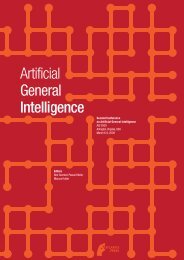Advances in Intelligent Systems Research - of Marcus Hutter
Advances in Intelligent Systems Research - of Marcus Hutter
Advances in Intelligent Systems Research - of Marcus Hutter
Create successful ePaper yourself
Turn your PDF publications into a flip-book with our unique Google optimized e-Paper software.
LP1 Sens<strong>in</strong>g a world state<br />
world_state(W, V) &<br />
connection_strength(world_state(W), sensor_state(W), ω)<br />
→ sensor_state(W, f(ωV))<br />
LP2 Generat<strong>in</strong>g a sensory representation for a world state<br />
sensor_state(W, V) &<br />
connection_strength(sensor_state(W), srs(W), ω)<br />
→ srs(W, f(ωV))<br />
In these specifications, the function f(W) (with W = ωV)<br />
can be specified by a threshold function h(σ, τ, W) =<br />
1/(1+exp(-σ(W-τ))), with steepness σ, and threshold τ, or<br />
simply by the identity function g(W) = W.<br />
In pr<strong>in</strong>ciple direct connections can be made from<br />
sensory representation states to preparation states (not<br />
depicted <strong>in</strong> Figure 2), or <strong>in</strong>termediate cognitive states can<br />
be used as depicted <strong>in</strong> Figure 2. Property LP3 describes the<br />
response to a cognitive state c <strong>in</strong> the form <strong>of</strong> the<br />
preparation for a specific (bodily) reaction b. This specifies<br />
part <strong>of</strong> the recursive loop between cognitive and affective<br />
states; see Figure 1. It is calculated based on a<br />
parameterised function f(W 1 ,W 2 ) <strong>of</strong> the orig<strong>in</strong>al levels V i<br />
(with W i = ω i V i ).<br />
LP3 Generat<strong>in</strong>g a preparation state<br />
cognitive_state(c, V 1) & feel<strong>in</strong>g(b, V 2) & preparation_state(b, V 3)<br />
& connection_strength(cognitive_state(c), preparation_state(b), ω 1)<br />
& connection_strength(feel<strong>in</strong>g(b), preparation_state(b), ω 2)<br />
→ preparation_state(b, V 3+γ 1 (f(ω 1V 1, ω 2V 2)-V 3) ∆t)<br />
In different applications <strong>of</strong> the generic agent architecture,<br />
two templates <strong>of</strong> functions f(W 1 , W 2 ) have been taken:<br />
g(β,W 1 , W 2 ) = β(1-(1-W 1 )(1-W 2 )) + (1-β)W 1 W 2<br />
h(σ, τ, W 1 , W 2 ) = 1/(1+exp(-σ(W 1 +W 2 -τ)))<br />
Note that the latter formula is <strong>of</strong>ten used as threshold<br />
function <strong>in</strong> neural models. The first formula describes a<br />
weighted sum <strong>of</strong> two cases. The most positive case<br />
considers the two source values as strengthen<strong>in</strong>g each<br />
other, thereby stay<strong>in</strong>g under 1: comb<strong>in</strong><strong>in</strong>g the imperfection<br />
rates 1-W 1 and 1-W 2 <strong>of</strong> them provides a decreased rate <strong>of</strong><br />
imperfection 1-(1-W 1 )(1-W 2 ). The most negative case<br />
considers the two source values <strong>in</strong> a negative comb<strong>in</strong>ation:<br />
comb<strong>in</strong><strong>in</strong>g the imperfections <strong>of</strong> them provides an <strong>in</strong>creased<br />
imperfection expressed by W 1 W 2 . The factor β is a<br />
characteristic that expresses the person’s orientation (from<br />
0 as most negative to 1 as most positive). The parameter γ 1<br />
<strong>in</strong>dicates the speed <strong>of</strong> change: how flexible the state is.<br />
A further choice was to use body loops and as if body<br />
loops for preparations <strong>of</strong> actions, adopted from (Damasio,<br />
1999, 2003; Bosse, Jonker, and Treur, 2008). This<br />
provides a second type <strong>of</strong> recursive loop: between<br />
preparation and feel<strong>in</strong>g states (see Figure 1).<br />
Thus a comb<strong>in</strong>ation <strong>of</strong> two loops is obta<strong>in</strong>ed, where<br />
connection strengths with<strong>in</strong> these loops <strong>in</strong> pr<strong>in</strong>ciple are<br />
person-specific (and might be subject to learn<strong>in</strong>g).<br />
Depend<strong>in</strong>g on these personal characteristics, from a<br />
dynamic <strong>in</strong>teraction with<strong>in</strong> and between the two loops, for<br />
a given stimulus an equilibrium is reached for the strength<br />
<strong>of</strong> the cognitive, preparation, and feel<strong>in</strong>g state.<br />
cognitive<br />
state<br />
Figure 1: The two recursive loops related to a cognitive state<br />
The existence <strong>of</strong> a connection from feel<strong>in</strong>g to cognitive<br />
state can be supported by Damasio’s Somatic Marker<br />
Hypothesis; cf. (Damasio, 1994, 1996, 2003; Bechara and<br />
Damasio, 2004). This is a theory on decision mak<strong>in</strong>g<br />
which provides a central role to emotions felt. Each<br />
decision option <strong>in</strong>duces (via an emotional response) a<br />
feel<strong>in</strong>g which is used to mark the option. For example,<br />
when a negative somatic marker is l<strong>in</strong>ked to a particular<br />
option, it provides a negative feel<strong>in</strong>g for that option.<br />
Similarly, a positive somatic marker provides a positive<br />
feel<strong>in</strong>g for that option. Usually the Somatic Marker<br />
Hypothesis is applied to provide endorsements or<br />
valuations for options for a person’s actions. However, it<br />
may be considered plausible that such a mechanism is<br />
applicable to valuations <strong>of</strong> <strong>in</strong>ternal cognitive states (e.g.,<br />
beliefs) as well. In detail the recursive loops between<br />
preparation and feel<strong>in</strong>g are specified by LP4 to LP8 (see<br />
also Figure 2). Here B is a variable for body states.<br />
LP4 From preparation to effector state for body modification<br />
preparation_state(B, V) &<br />
connection_strength(preparation_state(B), effector_state(B), ω)<br />
→ effector_state(B, f(ωV))<br />
LP5 From effector state to modified body state<br />
effector_state(B, V) &<br />
connection_strength(effector_state(B), body_state(B), ω)<br />
→ body_state(B, f(ωV))<br />
LP6 Sens<strong>in</strong>g a body state<br />
cognitiveaffective<br />
loop<br />
feel<strong>in</strong>g<br />
preparationfeel<strong>in</strong>g<br />
loop<br />
preparation<br />
state<br />
body_state(B, V) &<br />
connection_strength(body_state(B), sensor_state(B), ω)<br />
→ sensor_state(B, f(ωV))<br />
LP7 Generat<strong>in</strong>g a sensory representation <strong>of</strong> a body state<br />
sensor_state(B, V 1) & preparation_state(B, V 2) & srs(B, V 3) &<br />
connection_strength(preparation_state(B),srs(B), ω 1) &<br />
connection_strength(sensor_state(B), srs(B), ω 2)<br />
→ srs(B, V 3+γ 2 (f(ω 1V 1, ω 2V 2)-V 3) ∆t)<br />
LP8 From sensory representation <strong>of</strong> body state to feel<strong>in</strong>g<br />
srs(B, V) & connection_strength(srs(B), feel<strong>in</strong>g(B), ω)<br />
→ feel<strong>in</strong>g(B, f(ωV))<br />
Next the property for generation <strong>of</strong> the cognitive state c is<br />
described, where both a sensory representation <strong>of</strong> w and a<br />
feel<strong>in</strong>g <strong>of</strong> b play their role. This specifies another part <strong>of</strong><br />
98













